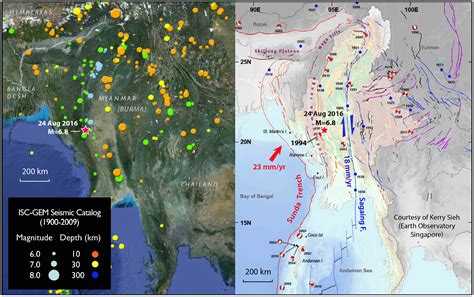As the dust settles in earthquake-battered Myanmar, a clearer picture emerges of the havoc wreaked by the powerful magnitude 7.7 quake that jolted Southeast Asia on March 28. The temblor not only toppled buildings but also claimed the lives of over 2,700 people, leaving behind a trail of destruction.
The rupture that triggered this catastrophic event unfolded along a vast stretch of approximately 1,400 kilometers known as the Sagaing Fault. With its epicenter just 10 kilometers below Earth’s surface near Mandalay, Myanmar felt the full brunt of nature’s fury.
### Understanding Liquefaction: A Hazardous Phenomenon
#### Expert Insight:
Susan Hough, Geophysicist:
“We sometimes explain the amplification of [ground] shaking as a bowl of Jell-O. But if the sediments are sandy and wet enough, it’s like quicksand.”
Liquefaction is a phenomenon where ground shaking causes loose sediment to behave like quicksand. When intense seismic activity disrupts loosely packed and water-laden sediments, it increases water pressure between grains, reducing soil strength to almost zero. This leads to ground instability and structural damage as foundations give way under liquefied soil.
### Vulnerable Delta Regions: A Recipe for Disaster
#### Expert Analysis:
Susan Hough:
“River deltas with thick sediments combined with seismic activity pose significant dangers.”
Regions like Mandalay in central Myanmar sit precariously close to river deltas prone to flooding and monsoons. The Irrawaddy River system traversing these areas adds to their vulnerability due to high water content in soils – setting an ideal stage for liquefaction disasters.
### Historical Precedents: Learning from Past Tragedies
#### Expert Insights:
Susan Hough:
“Past events like Mexico City ’85 quake highlight how liquefaction exacerbates damages.”
From historical earthquakes in Charleston (1886) and New Madrid (1811-1812) to San Francisco (1906), instances abound where liquefaction significantly compounded devastation – underscoring the need for preparedness measures in vulnerable regions worldwide.
### Challenges Faced Post-Earthquake
With limited local seismic data available post-quake due to communication disruptions following Myanmar’s political upheaval, efforts are underway to assess damages remotely. Despite logistical hurdles hindering physical presence on-site, collaborative initiatives aim to provide essential aftershock forecasts vital for mitigation strategies.
The risk remains palpable as experts predict continued seismic activities with significant probabilities for aftershocks looming large over affected areas – warranting sustained vigilance amidst ongoing recovery endeavors.
In conclusion, understanding how geological factors amplify natural disasters such as earthquakes equips communities with insights crucial for fortifying resilience against future calamities. Myanmarese lessons underscore the imperative need for proactive measures and robust infrastructure safeguards in vulnerable regions susceptible to nature’s unpredictable wrath.






Leave feedback about this